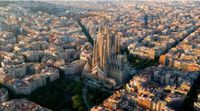Barcelona’s skyline has a new, record-breaking crown jewel. On November 2, 2025, workers set the first part of a cross atop the Sagrada Família’s central tower, marking a historic milestone for the iconic basilica. With this addition, the Sagrada Família now stands at an impressive 162.91 meters (534 feet), officially surpassing Germany’s Ulm Minster, which had held the title of the world’s tallest church since 1890, according to BBC and statements from the church itself. The achievement not only cements Barcelona’s place on the architectural world stage but also adds a fresh chapter to a story that’s been unfolding for over 140 years.
The Sagrada Família, designed by the visionary Catalan architect Antoni Gaudí, has been under construction in the heart of Barcelona since 1882. Gaudí, who took over the project in 1883, transformed the original, relatively modest design into his life’s magnum opus—a soaring, organic structure blending Catholic symbolism with forms inspired by nature. As reported by multiple outlets, including BBC and local Spanish media, the basilica’s central “Tower of Jesus Christ” will eventually reach 172 meters (564 feet) when the remaining parts of the cross are installed in the coming months. That will make the church even taller, firmly securing its place atop the world’s ecclesiastical architecture rankings.
The road to this record has been anything but smooth. When Gaudí died unexpectedly in 1926, only one of the planned 18 towers had been completed. The Spanish Civil War brought further setbacks; Catalan anarchists set fire to the crypt, destroying many of Gaudí’s original plans and plaster models, as BBC notes. Despite these challenges, the project endured, thanks in large part to the devotion of generations of architects, craftsmen, and donors who have kept Gaudí’s vision alive. The church has been funded mainly through private donations and, more recently, entrance fees from millions of tourists who visit each year.
The Ulm Minster in Germany, which the Sagrada Família has now surpassed, is itself a marvel of persistence and faith. Construction of the Ulm Minster began in the 14th century and wasn’t completed until the 19th century, finally reaching its full height of 161 meters (530 feet) in 1890. For more than a century, Ulm Minster’s Gothic spire has been the benchmark for church height—until now. As the Associated Press notes, the Sagrada Família’s new height is just over three feet taller than its German rival, a difference that’s small in numbers but huge in symbolic significance.
What’s perhaps most remarkable is that the Sagrada Família isn’t finished yet. According to statements from church officials and reporting from local sources, the main building is expected to be completed in 2026, coinciding with the 100th anniversary of Gaudí’s death. However, work on the church’s elaborate facades and intricate interior decoration is expected to continue for several more years, with some estimates suggesting a final completion date around 2035. The basilica’s ongoing construction has become a living testament to both Gaudí’s genius and the enduring spirit of Barcelona itself.
Gaudí could hardly have imagined the global phenomenon his basilica would become. Last year alone, 4.9 million people paid to visit the Sagrada Família, with 15% of those tourists hailing from the United States, as reported by the church. The influx of visitors has not only helped fund the ongoing work but also transformed the basilica into one of the world’s most recognizable religious landmarks. The combination of Gaudí’s distinctive aesthetic—marked by swirling stonework, organic shapes, and a forest of spires—and the church’s slow but steady rise has captivated people around the world.
“The Sagrada Família is not only a church, but a symbol of Barcelona and a monument to faith, perseverance, and creativity,” said a spokesperson for the basilica, as reported by BBC. The church’s status as a UNESCO World Heritage Site and its unique blend of Gothic and Art Nouveau styles have made it a must-see for travelers and architecture enthusiasts alike. Gaudí’s approach, which sought to harmonize the sacred with the natural world, is evident in every curve and detail of the structure.
The recent installation of the cross atop the central tower was a feat of engineering as much as artistry. According to local reports, a massive crane carefully hoisted the cross into place, watched by a crowd of onlookers and church officials. The cross is just the first part of what will eventually be a much larger structure crowning the Tower of Jesus Christ, the tallest of the basilica’s planned 18 towers. Over the next several months, workers will add the remaining sections, bringing the church to its full, awe-inspiring height of 172 meters.
The timing of this achievement is particularly poignant. Next year marks the centenary of Gaudí’s death, and the basilica plans to host a series of events to celebrate his legacy. Gaudí’s influence extends far beyond the Sagrada Família; his other works, such as Park Güell and Casa Batlló, are scattered throughout Barcelona, drawing millions of visitors each year. Yet it is the basilica—unfinished, ever-evolving, and now the tallest church in the world—that stands as the ultimate tribute to his genius.
The journey from the first stone laid in 1882 to today’s record-breaking height has been long and, at times, uncertain. The Sagrada Família has survived war, political upheaval, and the loss of its original architect. It has weathered criticism and controversy, as well as logistical and financial challenges that might have doomed a lesser project. Through it all, the people of Barcelona—and admirers from around the globe—have remained steadfast in their commitment to completing Gaudí’s dream.
As the basilica rises ever higher, so too does its symbolic significance. It’s a reminder that great works take time, sometimes generations, and that true beauty often emerges from patience, perseverance, and a willingness to dream big. The Sagrada Família’s new status as the world’s tallest church is more than a point of pride for Barcelona; it’s a testament to human ingenuity and faith, reaching skyward in stone and spirit alike.
